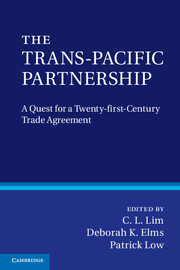Book contents
- Frontmatter
- Contents
- List of Figures and Tables
- Contributors
- Preface
- Acknowledgements
- Disclaimer
- Glossary
- Part I Introduction
- Part II The past: origins of the TPP Agreement
- 2 An overview and snapshot of the TPP negotiations
- 3 US PTAs
- 4 From the P4 to the TPP
- 5 Incorporating development among diverse members
- Part III The present: twenty-first century elements and obstacles
- Part IV The future: high-quality meets regional and global realities
- Part V The TPP negotiations: the quest for quality
- Index
- References
2 - An overview and snapshot of the TPP negotiations
Published online by Cambridge University Press: 05 November 2012
- Frontmatter
- Contents
- List of Figures and Tables
- Contributors
- Preface
- Acknowledgements
- Disclaimer
- Glossary
- Part I Introduction
- Part II The past: origins of the TPP Agreement
- 2 An overview and snapshot of the TPP negotiations
- 3 US PTAs
- 4 From the P4 to the TPP
- 5 Incorporating development among diverse members
- Part III The present: twenty-first century elements and obstacles
- Part IV The future: high-quality meets regional and global realities
- Part V The TPP negotiations: the quest for quality
- Index
- References
Summary
Starting with the “Pacific Four” Agreement
The Trans-Pacific Partnership (TPP) trade negotiations grew out of an earlier preferential trade agreement (PTA) now colloquially known as the “Pacific Four” (P4) Agreement. At several Asia-Pacific Economic Cooperation (APEC) meetings in the 1990s, Australia, Chile, New Zealand, Singapore and the United States held informal P5 discussions intended to discuss mechanisms for creating a new type of trade agreement among “like-minded” states.
These early discussions led officials from Chile, New Zealand and Singapore to launch negotiations on the sidelines of the APEC Leaders’ Summit in 2002 and to hold four rounds of negotiations on the Pacific Three Closer Economic Partnership (P3 CEP) between 2003 and 2005. At the fifth meeting of the interested parties in April 2005, Brunei Darussalam (henceforth Brunei) joined negotiations with the intention of becoming a founding member state of the Agreement. The successful conclusion of talks in the Trans-Pacific Strategic Economic Partnership Agreement (TPSEP, more commonly known as the P4) was announced at the APEC Trade Ministers’ Meeting in June 2005. The twenty chapters in the Agreement were accompanied by two memoranda of understanding (MOUs) on environmental and labour cooperation. Although the environmental and labour agreements were announced as separate documents, any state wishing to exit any one of the three agreements automatically exits the other two. The agreements came into force in 2006.
- Type
- Chapter
- Information
- The Trans-Pacific PartnershipA Quest for a Twenty-first Century Trade Agreement, pp. 21 - 44Publisher: Cambridge University PressPrint publication year: 2012
References
- 3
- Cited by



